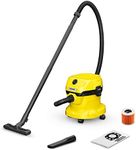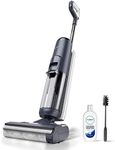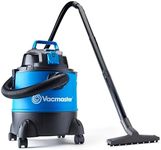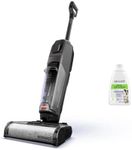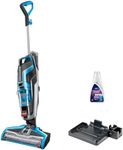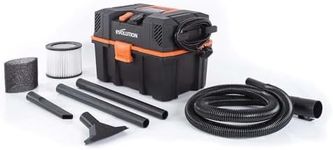Buying Guide for the Best Wet Dry Vacuum Cleaners
When choosing a wet-dry vacuum cleaner, it's important to consider the specific needs of your cleaning tasks. Wet-dry vacuums are versatile tools that can handle both liquid spills and dry debris, making them ideal for a variety of environments such as workshops, garages, and homes. To find the best fit for you, consider the size of the area you need to clean, the types of messes you typically encounter, and any additional features that might enhance your cleaning experience.CapacityCapacity refers to the volume of debris or liquid the vacuum can hold before needing to be emptied. This is important because a larger capacity means less frequent emptying, which can be convenient for larger cleaning tasks. Capacities can range from small (around 2-6 gallons) for light, occasional use, to large (12 gallons or more) for heavy-duty cleaning. If you frequently clean large areas or deal with significant amounts of debris or liquid, a larger capacity might be more suitable. For smaller, quick clean-ups, a smaller capacity could suffice.
PowerPower in wet-dry vacuums is typically measured in horsepower (HP) or amps, indicating the suction strength and efficiency of the motor. More power generally means better suction and the ability to handle tougher messes. Low-power models (around 1-2 HP) are suitable for light tasks, while medium-power models (3-4 HP) can handle more demanding jobs. High-power models (5 HP and above) are best for heavy-duty cleaning. Consider the types of debris and the frequency of use when deciding on the power level you need.
Hose Length and DiameterThe hose length and diameter affect the vacuum's reach and the size of debris it can handle. A longer hose allows you to clean larger areas without moving the vacuum, while a wider diameter can accommodate larger debris. Shorter hoses (around 6-8 feet) are easier to manage and store, while longer hoses (10 feet or more) offer greater reach. A standard diameter is usually around 1.25 to 2.5 inches. Choose based on the size of the area you need to clean and the type of debris you typically encounter.
Filtration SystemThe filtration system in a wet-dry vacuum is crucial for trapping dust and allergens, ensuring cleaner air is expelled back into the environment. Basic models may have a simple filter, while more advanced models offer HEPA filters that capture smaller particles. If you or anyone in your household has allergies or if you are working in a dusty environment, a vacuum with a high-quality filtration system is advisable. Consider your sensitivity to dust and allergens when choosing the filtration system.
PortabilityPortability refers to how easy it is to move the vacuum around. This is influenced by the vacuum's weight, the presence of wheels, and the design of the handle. Lightweight models are easier to carry and maneuver, making them ideal for quick clean-ups or use in multiple locations. Heavier models may offer more power and capacity but can be cumbersome to move. Consider where and how often you will need to transport the vacuum when evaluating portability.
Attachments and AccessoriesAttachments and accessories enhance the versatility of a wet-dry vacuum by allowing it to tackle a variety of cleaning tasks. Common attachments include crevice tools, brushes, and squeegees. These can help clean tight spaces, upholstery, or wet surfaces more effectively. Consider the types of surfaces and areas you will be cleaning to determine which attachments will be most useful for you. A vacuum with a good selection of attachments can provide more comprehensive cleaning solutions.
